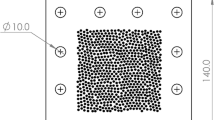Abstract
High-speed impact performance of composites of naval relevance is an important issue for analysing the reliability of components of battle ships produced with composite materials that may be subjected to impulsive loads in extreme conditions of temperature and aggressive environments. This paper presents preliminary results of a wide experimental research programme aiming to determine the response and failure of fibre-reinforced polymer composites of naval relevance under high-speed impact in extreme environments. Six different materials have been produced, namely S-2 glass, carbon, mate glass and hybrid glass/carbon woven fabric-reinforced vinyl ester matrix composites. The production method is by infusion of the resin into a vacuum mould. Impact tests have been carried out by shooting steel balls at speeds in the range of 200–600 m/s, approximately, by means of a compressed-gas gun. Impact velocities and residual velocities were measured by a high-speed camera and the corresponding software. Impact tests have been performed at room temperature 25 °C, as well as at low temperature − 50 °C, and high temperature + 50 °C. The whole experimental programme has been repeated by testing specimens previously conditioned by immersion in seawater up to saturation, aiming to analyse the influence of the aggressive environment on the performance of composites under high-speed impact. The experimental results, residual-velocity vs. impact-velocity curves and ballistic limits (impact velocity for 50% probability of target perforation), show no significant differences in the performance of all materials tested, although the best behaviour is observed in non-mixed hybrid glass/carbon reinforcement. On the other hand, saturated specimens show a slightly better behaviour except for low temperatures. Experimental results are compared with predictions of a new analytical model, previously developed by the authors. A good concordance is observed, showing that the analytical model may be a useful tool for predicting the response and failure of fibre-reinforced polymer composites under impact of different threats (fragments, bullets, etc.).












Similar content being viewed by others
References
Abrate S (1998) Impact on composite structures. Cambridge University Press, Cambridge
Cormier L (2017) Temperature effects on the static, dynamic and fatigue behaviour of composite materials used in wind turbine blades (Doctoral dissertation, École de de technologie supérieure)
Cormier, L., & Joncas, S. (2010) Effects of cold temperature, moisture and freeze-thaw cycles on the mechanical properties of unidirectional glass fiber-epoxy composites. In: 51st AIAA/ASME/ASCE/AHS/ASC structures, structural dynamics, and materials conference 18th AIAA/ASME/AHS adaptive structures conference 12th, 2010, p 2823
Cunniff PM (1992) An analysis of the system effects in woven fabrics under ballistic impact. Textile Res J 62(9):495–509
Cunniff PM (1996) A semiempirical model for the ballistic impact performance of textile-based personnel armor. Textile Res J 66(1):45–59
Department of Defense USA (2000) Composite materials handbook, vol 3. SAE International, United States
Fitzer E (1988) Composites for high temperatures. Pure Appl Chem 60(3):287–302
Gómez del Río T et al (2005) Damage in CFRPs due to low velocity impact at low temperature”. Compos B Eng 31(1):41–50
Grabovac I (2005) Composite reinforcement for Naval Ships. Concept design, analysis and demonstration. School of Applied Sciences, RMIT University, Melbourne
Lopresto V, Langella A, Abrate S (eds) (2017) Dynamic response and failure of composite materials and structures. Woodhead Publishing, Duxford
Paradela LS, Sánchez-Gálvez V (2013) Analytical simulation of high-speed impact onto composite materials targets. J Strain Anal Eng Des 48(5):282–290
Rupert NL, Blethen WC (2010) Dyneema fabric data set for the calibration of fabric penetration models. In: 25th Int Symposium on Ballistics, Beijing, China, May 2010, pp. 1429–1436
Sánchez-Gálvez V, Sánchez-Paradela L, Gálvez F (2014) Analytical simulation of high-speed impact onto hybrid glass/carbon epoxy composites targets. Proc Eng 88:101–108
Sánchez-Gálvez V, Gálvez F, Sancho R, Cendón D (2017) A new analytical model to simulate high-speed impact onto composite materials targets. Int J Impact Engng 108:322–333
Schutz JB (1998) Properties of composite materials for cryogenic applications. Cryogenics 38(1):3–12
Shenoi RA, Dulleu-Barton JM, Quinn S, Blake JIR, Boyd SW (2011) Composite materials for Marine applications. Key challenges for the future. School of Engineering Sciences, University of Southampton, Southampton
Stone MA, Fink BK, Bogetti TA, Gillespie JW Jr (2000) Thermo-chemical response of vinyl-ester resin. Polym Eng Sci 40(12):2489–2497
Syngellakis S (2014) Projectile Impact. Modelling Techniques and Target Performance Assessment. WIT Press, Ashurst
Acknowledgements
Authors are indebted to the Office of Naval Research for funding the research in the Solid Mechanics Program under the direction of Dr. Rajapakse.
Author information
Authors and Affiliations
Corresponding author
Ethics declarations
Conflict of interest
On behalf of all authors, the corresponding author states that there is no conflict of interest.
Rights and permissions
About this article
Cite this article
Sánchez-Gálvez, V., Cendón, D., Sancho, R. et al. Performance of composite materials under high-speed impact in extreme environments. Multiscale and Multidiscip. Model. Exp. and Des. 2, 97–104 (2019). https://doi.org/10.1007/s41939-018-0035-7
Received:
Accepted:
Published:
Issue Date:
DOI: https://doi.org/10.1007/s41939-018-0035-7




